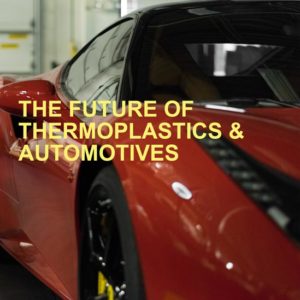GOAL →→ SPEED & EFFICIENCY
The automotive industry is busy constructing cars with more thermoplastic materials every year to reduce their overall weight to make them more efficient. As fuel-efficiency and emissions targets become increasingly strict across the world, the automotive industry must continue to innovate and redesign to create better aerodynamics, less rolling resistance, alternative drivetrain solutions, and most of all, lighter materials.
Needing Lighter Materials
Consumer in-demand components are also being added to cars more than ever, and therefore weight must be removed from other parts of the vehicle. Multiple material industries, such as thermoplastics, composites, steel, or aluminum, are all working to create lighter weight solutions for the automotive industry. While many solutions will come from a combination of these materials, the plastics and composites industry is leading the way with thermoplastic-based materials. These materials have high strength and rigidity, low density, and tailored thermal expansion properties as well as recyclability.
Bonding with Thermoplastic Adhesive Films
Thermoplastic adhesive films are one of the most convenient methods of assembling thermoplastic parts or metal parts together. The adhesive on the hot-melt films distribute the stress over the entire bonded surface area and can provide airtight seal if needed. Other advantages of thermoplastic adhesive films include the ease of application, elasticity, flexibility, and its low cost.
Thermoplastic materials and thermoplastic adhesive tapes and films are currently being used in front and rear bumpers. Not only are they lighter than their metal counterparts and bolts, but they also absorb energy better and are more flexible. Additionally, the plastic bumper is less costly than its metal counterpart. Automotive manufacturers are also looking to replace metal in several other structural applications, like door modules, instrument panels, inner tailgate components, and front-end modules.
More Thermoplastic, Please
Another area where thermoplastics are in use is the battery-pack systems of electric vehicles. With the added weight of a large battery comes a need to reduce weight in other areas. Resins in the battery-pack system help keep the battery stable, regardless of changes in temperature, humidity, and load. Resins also help offset the weight of the battery itself.
While great strides are being made in reducing weight, manufacturing time, and cost; manufacturers continue to develop and test new ideas. Currently, they are working to develop hybrid solutions that combine the strengths of thermoplastic and metal. Perhaps the biggest project under development within the automotive industry is creating an all-plastic tailgate.
In 2016, thermoplastics made up about 50% of a vehicle’s total volume, but only 10% of the vehicle’s total weight. Many advancements are driven by fuel efficiency and emissions targets. However, safety improvements are also a priority. Solutions that combine the strengths of thermoplastic with other materials bonded together by thermoplastic adhesive films will be important as manufacturers seek to include more plastic in vehicular design.

